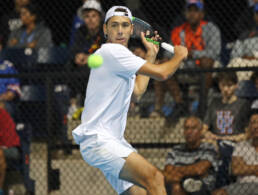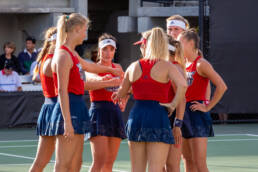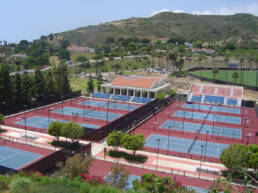t e n n i s
College tennis is very popular in the United States. The structure and point system is slightly different from what most players are used to. In the United States, there are over 900 universities fielding men’s and women’s tennis teams. At the top universities in the US we often find players who already have an ITF ranking or even some ATP points. These universities have a very professional structure, with renowned coaches, physiotherapists, physical and mental trainers and many other advantages. However, it is important to know that some universities will be less prestigious than others and therefore have less good tennis facilities. This will not prevent the student from fulfilling his or her potential by continuing his or her studies, practicing tennis daily with teammates, and competing at regional and national levels to represent the university.

Choosing between tennis and studies?
At most universities it will be possible to combine sport and studies effectively. However, there are of course some universities that are better rated academically, others that have better tennis facilities for high level competition Before making your final choice, it is essential to determine in advance which of the two projects you wish to pursue, sport or academic.
The level of scholarship eligibility and the geographical area may also be factors to consider. Some players will aim to go professional after their university education. Therefore, it would be important for them to find a university that has a very competitive tennis team and also plays in a successful league. Other players may want to use their tennis skills to get into a university with a strong academic reputation, such as Harvard, Yale, or Princeton. Other universities such as Stanford, Duke, or UCLA are also highly regarded academically as well as athletically, but the budget will also be larger, and it will be more difficult to meet the admission requirements. Families who can’t afford to spend a lot of money on their child will prefer universities that offer a substantial scholarship, while families with a larger budget may want to consider a university with a higher tennis or academic reputation.
Tennis Season
- Fall Season: August-December (practice period, physical training, exhibition matches against teams not in your conference, ITF or Challenger tournaments, invitational tournaments)
- Spring Season: January-May (college matches against teams in your conference, conference tournament with the top 8 teams in your conference, college national championship if you win your conference tournament)
The most important season for a tennis coach is the “Spring Season”.

NCAA videos
Click here to watch videos of the Division I, Division II and Division III college national championship finals:
Trainings and players
- 4 to 6 training sessions per week
- 2 to 3 hours of training per day
- 2 to 4 physical training sessions per week
- Between 8 and 15 players per team (6 singles and 3 doubles per match)
- Training matches to determine who will play in the top 6 in matches
- The coach chooses his top 6 according to the attitude and performance of the players in training, in practice matches, in official matches, but also according to their attitude off the court, their academic results, and other criteria.
The American rules are not all the same compared to the tournaments you are used to playing
- No warm-ups with the opposing team are allowed.
- The 6 singles are played at the same time just after the 3 doubles (which will also be played at the same time) have finished.
- The games are played without advantage, so at 40-40 there is a decisive point.
- The matches are played with the no-let, so the net counts, even when serving
- You can cheer for your teammates during the points.
- The first university team to get 4 points wins the match.
- The team gets 1 point for each singles won and 1 point for the doubles if the team wins at least 2 of the 3 doubles.
- Doubles are played to the best of 8 games (Tie-Break at 7-7).
- The player himself can decide if the ball was out or not and not the referee. However, if the referee has seen the ball and thinks that the player has made a mistake, he has the right to change the decision of the player.
- Each player is entitled to 1 medical time out per match.

Ranking to be accepted in a DI, DII, DIII or NAIA
These questions will be answered during our first free consultation and after reviewing your online form!
A typical day for a tennis player
- 7am: Breakfast
- 7:30-8:30: Fitness or individual training
- 9am – 12:30pm: University course
- 12:45 – 1:45: Lunch and rest
- 14h00 – 16h30: Tennis training with the team
- 17:00 – 18:00: Care or Fitness
- 6:30 pm: Dinner
- 20:00 – 21:30: Study/Homework

Alumni and current ATP / WTA players who have played for a university in the US while pursuing a university education:
- John Isner – University of Georgia
- Kevin Anderson – University of Illinois
- Cameron Norrie – Texan Christian University
- Steve Johnson – University of Southern California
- Dominik Koepfer – Tulane University
- Tennys Sandgren – University of Tennessee
- Arthur Rinderknech – Texas A&M University
- Ben Shelton – University of Florida
- Alexander Ritschard – University of Virginia
- Rajeev Ram – University of Illinois
- Joe Salisbury – University of Memphis
- Jenson Brooksby – University of Baylor
- Francisco Cerundolo – University of South Carolina
- Maxime Cressy and Marcos Giron – UCLA
- Jennifer Brady – University of California, Los Angeles
- Danielle Collins – University of Virginia
- Nicole Gibbs – Stanford University
- Anne Kremer – Stanford University


